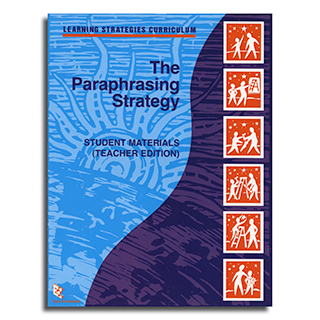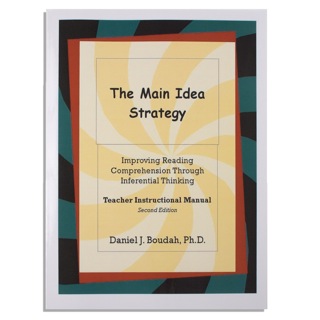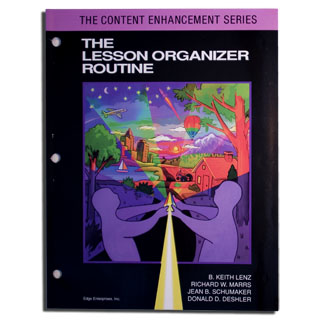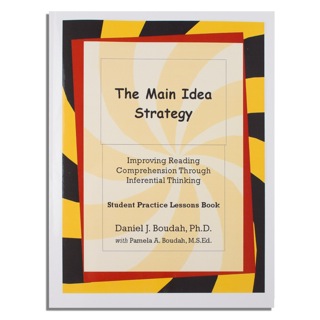Description
Research on the Paraphrasing Strategy
Study 1
Overview
This study investigated the effects of instruction in the Paraphrasing Strategy. Six students with LD in grades 10 through 12 were taught using the eight-stage instructional methodology for strategy instruction. A multiple-baseline across-students design was used to demonstrate experimental control. Students were instructed to stop at five points while they were reading each passage. At each point, they were asked to tell the researcher about what they had read. The student’s response was scored as an accurate paraphrase according to a set of written guidelines. In addition, the students took a comprehension test over the content of the passage on the day after reading each passage. The passages were written at each student’s ability level and other passages were written at the student’s grade level.
Results
The results showed that all the students mastered applying the Paraphrasing Strategy. As the number of points they earned on paraphrases increased, the percentage of questions answered correctly on the comprehension test also increased. The students required an average of four practice attempts to reach the mastery criterion (80% correct) on ability level passages. During baseline, the students earned a mean of 0% of the paraphrasing points available for paraphrases constructed on both ability-level and grade-level passages. Also during baseline, they answered a mean of 52% of the questions correctly over ability-level passages and a mean of 49.5% of the questions correctly over grade-level passages. After instruction, they earned a mean of 71% of the paraphrasing points available and answered a mean of 86% of the questions correctly over ability-level passages. They earned a mean of 71% of the paraphrasing points available and answered 84% of the questions correctly over grade-level passages. The students were reading, on average, at the 5.9 grade level (range = 3.8 to 7.7) when they began the study. At the end of the study, they were performing the strategy and earning an average comprehension score of 84% on passages written, on average, at the 10.5 grade level.
Conclusions
Thus, this study showed that students could master the Paraphrasing Strategy and that as their paraphrasing scores increased, their comprehension scores increased. In addition, they were able to earn average comprehension scores above the 80% level on passages written at their grade level after instruction. They improved an average of five grade levels with regard to reading comprehension of criterion-based passages.
Reference
Schumaker, J. B., & Deshler, D. D. (1992). Validation of learning strategy interventions for students with LD: Results of a programmatic research effort. In B. Y. L. Wong (Ed.), Intervention research with students with learning disabilities (pp. 22 – 46). New York: Springer-Verlag.
Study 2
Overview
In this study, the Paraphrasing Strategy and the Self-Questioning Strategy were taught to a 9th-grade English class containing 23 students. A comparison class contained 25 students. Three students with disabilities, three high-achieving students, and three low-achieving students within each class served as targeted subjects for a multiple-probe across-strategies design. Thus, a comparison-group design was combined with a multiple-probe design so that individual student results could be highlighted as well as group results. The students in the experimental class received instruction in the strategies through the use of the eight-stage instructional methodology for teaching strategies combined with cooperative-group structures. Students in the comparison class received traditional English class instruction. Measures included a measure of the performance of each strategy and a comprehension measure.
Results
The results showed that the students with LD and low-achieving students in the two classes were somewhat comparable at the beginning of the study. With regard to the percentage of correct paraphrased statements, students with LD and low achievers earned average scores of 50% and 40% in the experimental class and 48% and 35% in the comparison class, respectively. The class as a whole earned an average paraphrasing score of 50% in the experimental class and 47% in the comparison class.
All the targeted students in the experimental class mastered both strategies after the instruction as shown by the multiple-probe design. With regard to paraphrasing, the experimental students with LD and low achievers earned mean scores of 80% and 90%, respectively. All experimental students earned a mean paraphrasing score of 90%. The comparison students with LD and low achievers earned mean scores of 60% and 50%, respectively. The mean score for all the comparison students was 40%.
Mean comprehension scores on criterion-referenced tests also increased for the experimental students. For example, the mean comprehension score for the experimental students with LD on grade-level materials increased from 24% to 70%; for experimental low achievers, it increased from 30% to 70%. For all experimental students, it increased from 50% to 70%. The only group to make gains in comprehension in the comparison class was the low-achieving group. Their mean comprehension score on grade-level materials increased from 48% to 60%.
Conclusions
Thus, this study showed that reading strategies can be taught in an inclusive general education high-school class in such a way that students make substantial gains in their reading skills and comprehension. Nevertheless, these results were achieved when the eight-stage strategic instructional methodology was used, and students had multiple opportunities to practice using each strategy. They also received help and feedback from peers in their cooperative groups. The cooperative-group structure was designed in such a way that the students would help and encourage each other to master each strategy (i.e., points were awarded to individuals according to how well all members of the group performed on the strategies).
Reference
Beals, V. L. (1983). The effects of large-group instruction on the acquisition of specific learning strategies by learning disabled adolescents. Unpublished doctoral dissertation, University of Kansas, Lawrence.







